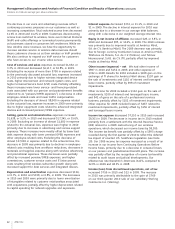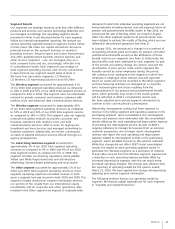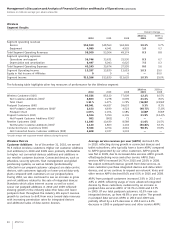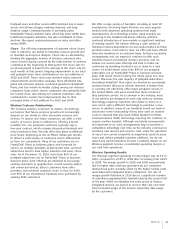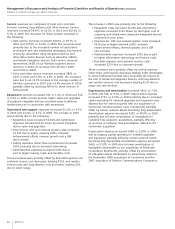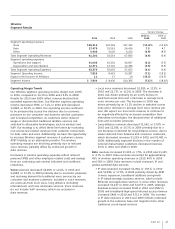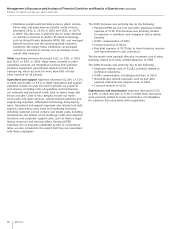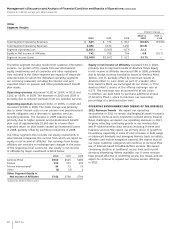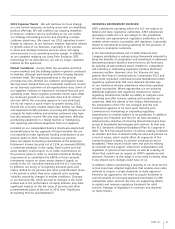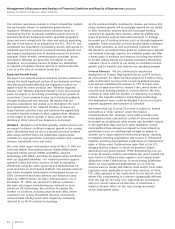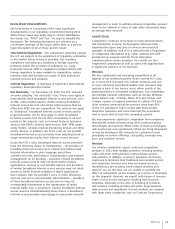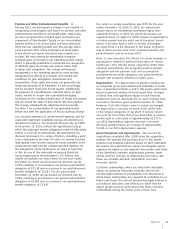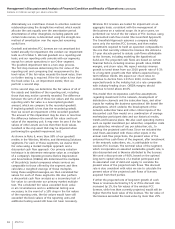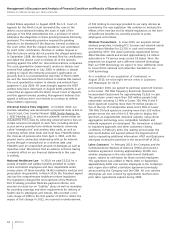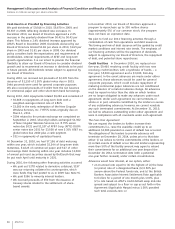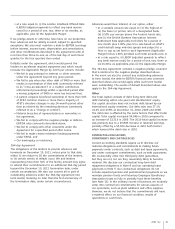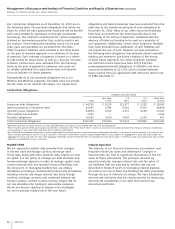AT&T Wireless 2010 Annual Report Download - page 44
Download and view the complete annual report
Please find page 44 of the 2010 AT&T Wireless annual report below. You can navigate through the pages in the report by either clicking on the pages listed below, or by using the keyword search tool below to find specific information within the annual report.
Management’s Discussion and Analysis of Financial Condition and Results of Operations (continued)
Dollars in millions except per share amounts
42 AT&T Inc.
As the wireless industry continues to mature, we believe that
future wireless growth will increasingly depend on our ability
to offer innovative services that will encourage existing
customers to upgrade their services, either by adding new
types of services, such as data enhancements, or through
increased use of existing services, such as through equipment
upgrades. These innovative services should attract customers
from other providers, as well as minimize customer churn.
We intend to accomplish these goals by continuing to expand
our network coverage, improve our network quality and offer
a broad array of products and services, including free mobile-
to-mobile calling among our wireless customers. Minimizing
customer churn is critical to our ability to maximize revenue
growth and to maintain and improve our operating margins.
U-verse Services We are continuing to expand our
deployment of U-verse High Speed Internet and TV services.
As of December 31, 2010, we have passed 27.3 million living
units (constructed housing units as well as platted housing
lots) and are marketing the services to 77% of those units.
Our rate of expansion will be slowed if we cannot obtain all
required local building permits in a timely fashion. We also
continue to work with our vendors on improving, in a timely
manner, the requisite hardware and software technology.
Our deployment plans could be delayed if we do not receive
required equipment and software on schedule.
We believe that our U-verse TV service is subject to federal
oversight as a “video service” under the Federal
Communications Act. However, some cable providers and
municipalities have claimed that certain IP services should
be treated as a traditional cable service and therefore subject
to the applicable state and local cable regulation. Certain
municipalities have delayed our request or have refused us
permission to use our existing right-of-ways to deploy or
activate our U-verse-related services and products, resulting
in litigation. Pending negotiations and current or threatened
litigation involving municipalities could delay our deployment
plans in those areas. Petitions have been filed at the FCC
alleging that the manner in which we provision “public,
educational and governmental” (PEG) programming over our
U-verse TV service conflicts with federal law, and a lawsuit has
been filed in a California state superior court raising similar
allegations under California law. If courts having jurisdiction
where we have significant deployments of our U-verse
services were to decide that federal, state and/or local cable
regulation were applicable to our U-verse services, or if the
FCC, state agencies or the courts were to rule that we must
deliver PEG programming in a manner substantially different
from the way we do today or in ways that are inconsistent
with our current network architecture, it could have a
material adverse effect on the cost, timing and extent
of our deployment plans.
Our wireless operations operate in robust competitive markets
but are likewise subject to substantial governmental
regulation. Wireless communications providers must be
licensed by the FCC to provide communications services at
specified spectrum frequencies within specified geographic
areas and must comply with the rules and policies governing
the use of the spectrum as adopted by the FCC. The FCC has
recognized the importance of providing carriers with access to
adequate spectrum to permit continued wireless growth and
has begun investigating how to develop policies to promote
that goal. While wireless communications providers’ prices
and service offerings are generally not subject to state
regulation, an increasing number of states are attempting
to regulate or legislate various aspects of wireless services,
such as in the area of consumer protection.
Expected Growth Areas
We expect our wireless services and data wireline products to
remain the most significant portion of our business and have
also discussed trends affecting the segments in which we
report results for these products (see “Wireless Segment
Results” and “Wireline Segment Results”). Over the next few
years, we expect an increasing percentage of our growth to
come from: (1) our wireless service and (2) data/broadband,
through existing and new services. We expect that our
previous acquisitions will enable us to strengthen the reach
and sophistication of our network facilities, increase our
large-business customer base and enhance the opportunity
to market wireless services to that customer base. Whether,
or the extent to which, growth in these areas will offset
declines in other areas of our business is not known.
Wireless Wireless is our fastest-growing revenue stream and
we expect to deliver continued revenue growth in the coming
years. We believe that we are in a growth period of wireless
data usage and that there are substantial opportunities
available for next-generation converged services that combine
wireless, broadband, voice and video.
We cover most major metropolitan areas of the U.S. with our
Universal Mobile Telecommunications System/High-Speed
Downlink Packet Access (HSPA) and HSPA+ network
technology, with HSPA+ providing 4G speeds when combined
with our upgraded backhaul. Our network provides superior
speeds for data and video services, as well as operating
efficiencies using the same spectrum and infrastructure for
voice and data on an IP-based platform. Our wireless network
also relies on digital transmission technologies known as
GSM, General Packet Radio Services and Enhanced Data
Rates for GSM Evolution for data communications. As of
December 31, 2010, we served 95.5 million customers.
We have also begun transitioning our network to more
advanced LTE technology. We continue to expand the
number of locations, including airports and cafés, where
customers can access broadband Internet connections
using wireless fidelity (local radio frequency commonly
referred to as Wi-Fi) wireless technology.


